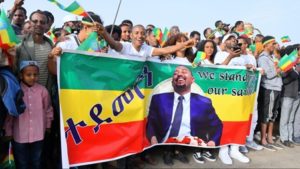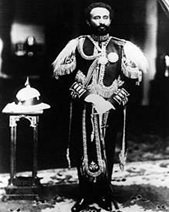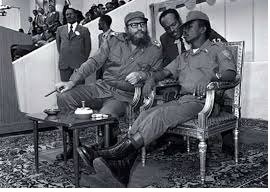By Hassan Ugas Mohamed
As the children’s story goes, the eponymous character, Humpty Dumpty, had many falls and broke many pieces and every time Humpty falls the king’s army of men were able to put Humpty back together until one day Humpty sat on a wall and had a great fall where all of the king’s men and all of the king’s horses could not put Humpty together again.

Similarly, Ethiopia has had similar episodes of Humpty moments in the past where the disfigurement of the nation seemed inevitable, however time and again, Ethiopia survived. Today’s crises are more challenging because there is a new sheriff in town, an Oromo. The question on the mind of many now is whether the Oromo population, who account for nearly half of the nation’s 100 million people, will continue the tradition of oppression that they themselves have suffered from for centuries. The unrest and uncertainty gripping the country begs only one question to be asked, could these crisis be the straw that finally broke the camels’ back, and signal the demise of Ethiopia as we currently know it?
Ethiopia is a country like no other in the modern world, steeped in ancient history that has lived on into the present in areas of the country lay untouched by the industrial revolution. However it is in this diversity that Ethiopia has also found its greatest weakness. Ethiopia’s cycle of instability is rooted in its very foundation. Since the beginning the history of the Non-Habesha population have been overlooked and disregarded in favor of a narrative that glorifies the Habesha.
For instance, the visitors of Ethiopian museum in Addis Ababa today see a great collections of king’s attires and amazing imperial artifacts on display, among them, Queen Sheba, King Najash and the Gonder Dynasty. However, that glamour belongs to Abyssinia which has a rich and well established recorded ancient history which pre-dates modern Ethiopia,
Notably missing in the history books are Ahmed Gurey (aka Grang) and Sayid Muhammad Abulle Hassan, dubbed “mad mullah” by the British for his fierce opposition to occupation. Even though both men are considered by many to be symbols of Somali pride and nationalism, nevertheless, they fought inside the territorial boundaries of today’s Ethiopia and their legacy should be equally important to today’s Ethiopian youth and should be referenced in the libraries, museums and other literature materials.
The first Humpty moment of Ethiopia after its inception by Menelik II came when Italy invaded Ethiopia in 1935. After a brief resistance war that lasted seven months, the fascist army was able to conquer Ethiopia and enter the capital in May of 1936.

Emperor Haile Selassie fled the country and Italy completed their offense and created the Italian East Africa colony. Ethiopia survived when the monarchy was restored by a British led coalition in 1941.
One of the constant stress triggers in Ethiopia’s instability is the legacy of colonial border disputes. For starters, parts of Ethiopia and Somalia’s long boundary was never properly demarcated and as of today, Somalia never fully recognized the border between the two nations.
Upset at what he viewed as an immoral occupation of land that was historically Somali, Siad Barre, the Somalia’s military leader incubated and supported various ethnic groups who were dissatisfied Amhara dominated Ethiopia. These groups included the Eritrea Patriotic Liberation Fronts (EPLF), the Tigray People’s Liberation Fronts (TPLF), the Western Somali Liberation Fronts (WSLF), and the Oromo Liberation Fronts (OLF). At the end Somalia invaded Ethiopia. The second humpty episode culminated during Ethiopia and Somali war of 1977 (Ogaden war). Somalia’s heavily armored forces easily overrun the poorly equipped Ethiopian military and Ethiopia only survived when the Soviet and the eastern allies switched sides and came to the rescue of then what was a newly minted socialist regime.
The collapse of the Soviet Union immensely diminished Ethiopia’s ability to wage and maintain wars on multiple fronts. Most of Eritrea’s territory fell in the hands of EPLF and the country once again seemed to be in the last throes of its existence.
The western world, represented by America’s then Ambassador to Ethiopia Herman Cohen Initially attempted to convince the EPLF to lead a coalition that would replace, Mengistu Haile Mariam, but when EPLF rejected his offer he turned to the smaller TPLF to lead the country. Previously little known guerilla by the name of Meles Zenawi inherited a landlocked country and managed to keep it from falling apart for the next 25 years through brute force but Ethiopia survived.

After the passing of Meles Zenawi, his deputy premier Haile Mariam Desalegn was selected as the caretaking prime minster until the following general election. Ethiopia is a nation where the strong conquers the weak, and since Haile Mariam Desalegn did not hail from one of the stronger tribes his authority was limited and seen as inauthentic. Due to massive youth under employment and uncertainties surrounding the direction the nation was heading, mass protests and demonstrations erupted which forced Haile Mariam to resign and elevated Abiy Ahmed to the crown.
What went well since Abiy became the premiere?
Gifted with charisma and the ability to deliver Obama like speeches, Abiy wasted no time to differentiate himself from the previous regimes, describing some of their practices like a “day time Hyenas”. He pledged transparency and immediately freed countless prisoners. He visited all of the regions of the federation and embarked on a worldwide shuttle diplomacy to neighboring and to international states. He restored diplomatic ties with Eritrea, a task worthy of noble peace prize consideration in my opinion.
Potential pitfalls?
After enduring and suffering long in the hands of the Amhara and Tigray rulers, the Oromo’s expect a lot from the young prime minister. It is those high expectations that keeps me worried of what would happen if the Qeerro movement, the power behind the wind that catapulted Abiy to the leadership, became dissatisfied with his government. Would they take to the streets and demand more concessions, and what would those demand be?
Another potential sinkhole is the long simmering and currently smoldering rift between the Oromo and the Somali communities. The Oromo and Somali communities have more in common than separates them. The two regional leadership disagree over how the conflict started, and have different perspective of which side is keeping the fires burning. The Oromo’s blame Abdi Iley and the Somali region’s police, TPLF army generals, and top members of the EPRDF party echelons. They say Abdi Iley’s Liyu police attacked innocent Oromo’s to weaken the Oromo uprising against the Tigray led government.
On the other hand, the Somalis believe that Oromo politicians used their clout as a member of the ruling EPRDF party to transfer a large swath of their land to Oromia through sham referendums and want for more. Somalis also say that Abiy provides cover for the Lemma Megarsa, and the Oromia region by emphasizing the number of displaced Oromo’s from Jigjiga, Djibouti and other parts of Somalia. In a nutshell, Somalis have their doubts on whether an Oromo led federal government could be an honest broker of peace between the two.
The federal government publicly stated that the federal army is in charge of the security of the Somali region and the surrounding peripheries, however, as recently as early August of this year nearly 40 people have died and it would be hard to reasonably pin this killing on Abdi Iley as he is no longer in power.
Oromia is the largest region in the federation, the most populous, and the most fertile. The Somali region, on the other hand, is the third populous, second largest, and has an abundance of resources including proven gas and oil reserves. Restoring peace to the border between the two regions should be a priority for federal government.
If the hostility between the Somali and Oromo regions can’t be tempered soon it can bring unrest to the rest of the regions. It can also Segway into currently dormant but lethal alliance between Tigray and Amhara regions. A coalition of Tigray and Amhara against Oromo led federal government can easily turn to a bloody civil war. It can also turn to the final Humpty moment of Ethiopia, the country.
Ethiopia is hurting, Somalia is hurting, Eritrea is hurting and the whole of horn of Africa is hurting. People are yearning for peace. If the federal government of Ethiopia can’t bring peace and solve current challenges it may not survive and can bring the whole of East Africa down with her.
Hassan Ugas Mohamed
Email: [email protected]
We welcome the submission of all articles for possible publication on WardheerNews.com. WardheerNews will only consider articles sent exclusively. Please email your article today . Opinions expressed in this article are those of the author and do not necessarily reflect the views of WardheerNews.
WardheerNew’s tolerance platform is engaging with diversity of opinion, political ideology and self-expression. Tolerance is a necessary ingredient for creativity and civility.Tolerance fuels tenacity and audacity.
WardheerNews waxay tixgelin gaara siinaysaa maqaaladaha sida gaarka ah loogu soo diro ee aan lagu daabicin goobo kale. Maqaalkani wuxuu ka turjumayaa aragtida Qoraaga loomana fasiran karo tan WardheerNews.
Copyright © 2024 WardheerNews, All rights reserved


